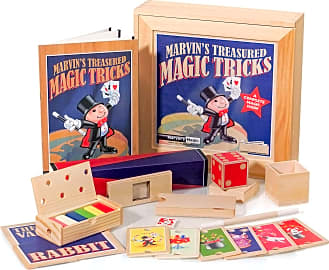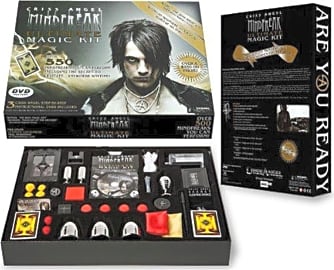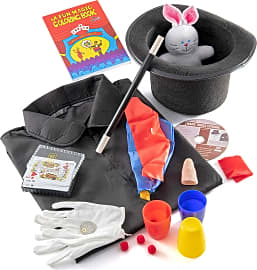The 10 Best Magic Kits

This wiki has been updated 45 times since it was first published in October of 2015. Seeing a skillful magician perform can inspire those in the audience to learn the tricks of the trade in the hope of becoming the next Houdini or Penn Jillette. Whether you’re looking for a kit geared toward adults or children, the sets featured here can teach impressive illusions like breaking apart a set of linked rings, making things disappear, and pulling a rabbit out of a top hat. When users buy our independently chosen editorial selections, we may earn commissions to help fund the Wiki.
Editor's Notes
October 21, 2020:
We removed the Fantastma Toys Ultimate Legends Of Magic due to availability concerns and replaced Jim Stott's Ultimate Street Magic with Jim Stott’s Ultimate Money Magic, a more specialized kit that focuses on tricks that use real coins and bills as props (as well as some special equipment and coins that are included). The Marvin's Magic Treasured is unique in that all of the pieces are made of wood, instead of the plastic components that populate most magic kits. This is a great choice for magic enthusiasts who are looking for decorations or collectors' items, as well as kids looking to learn classic tricks. Also new to the list, the Prextex Kiddie may not have as many tricks as most of the options available, but it does come with a complete costume consisting of a cape, hat, gloves, wand, and stuffed rabbit, so it's a good choice for kids who want to perform at a talent show or be a magician for Halloween.
December 10, 2019:
Joining the list today is the Melissa & Doug Abracadabra Collection, which is from a popular manufacturer of a wide range of toys for young children. This set is suitable for anyone age four and up, and comes with 10 pieces and an easy-to-follow, illustrated set of instructions. Kids will have fun, learn social skills, and improve coordination as they change a king card to a queen, make silk change colors, and wave a magical wand. For a larger set from the same manufacturer, look to the Melissa & Doug Deluxe Set, which comes with a host of easy-to-master classic tricks like a vanishing ball, a disappearing coin, a money maker, a number prediction game, and more.
Our selection also features two sets from a magician who has been entertaining audiences since 1976: The Jim Stotts' Ultimate Magic Kit and the Jim Stott's Ultimate Street Magic. Both are packed with tricks and illusions, with the latter containing more portable props you can keep in a pocket or backpack to perform impromptu magic just about anywhere.
For a set from another popular magician, consider the Criss Angel Ultimate Magic Kit, which comes with DVD that teaches more than 550 tricks including levitation, a money printer, and classic cups and balls illusions.
For safety’s sake, always comply with a manufacturer’s age-related guidelines when giving these to children, as many of them contain small parts and are not suitable for a small child. With any toys, always supervise children for a safe playtime.
Special Honors
Custom Magic Kits Deluxe Whether you’re a birthday party magician, one who teaches classes, or one who performs at corporate gigs, you’ll appreciate this boxed kit that can be customized with your name, photo, and website. Inside are commonly used props like cups and balls, a vase, shrinking coins, a sliced rope, and much more. Also included are an instructional booklet and a bonus 50 tricks booklet. It all comes organized in a compartmentalized plastic tray. custommagickits.com
A Series of Tricks That Every Magic Kit Should Include
Most people have seen some version of the linking rings trick.
Any magic kit that's worth its salt should come with a deck of cards and a magic wand. The deck can be used for any number of tricks. The wand can be used as a distraction, or for storing objects, or for coiling up to reveal a big surprise.
Certain kits may come with a cape (keep an eye out for several hidden pockets sewn into the lining). Certain kits may also come with a series of handkerchiefs, which can be jammed into a sleeve. Certain kits may feature a mystic box, which can be used to make objects magically disappear, and then reappear. And certain kits may come with some type of slipknot rope, or linking rings.
Most people have seen some version of the linking rings trick. This is when three metal rings are presented, each of them locked together much like links in a chain. One sleight of hand and the rings begin to separate. This is the same basic premise behind a knotted rope which is pulled tight, before being slipped free.
In the world of magic everything has a dual purpose. Top-of-the-line kits are built to behave as their own magic tables (complete with some hidden compartments); stovepipe hats are designed to be collapsible so that they can fit inside a box. Yet, despite this, the most important aspect of any magic kit remains a simple how-to manual. If the magician's code can be thought of as a labyrinth, then a simple how-to manual is the equivalent of a torch in the dark.
What Can I Use a Magic Kit For?
If you're an experienced magician, chances are you don't have any need for a basic magic kit. You've learned those tricks and you've bought those props. As a result, most of today's magic kits are being sold to everyday adults. In select cases, these adults are buying the kits for their children. In other cases, these adults are interested in learning the magic tricks themselves.
If you live in the country, performing magic might pass the time during an extended car ride.
Consider babysitters, for example, who can use the tricks in any magic kit to confound the kids who they are watching for hours at a time. Likewise, any elementary school teacher can keep a magic kit in the classroom to either entertain or teach her students. Any high school teacher can use a magic trick to demonstrate the laws of physics, and any algebra teacher can use a magic trick to demonstrate the laws of math.
Magic kits are a great way to build rapport with any youngster, and complex magic is a great way to break the ice with any adult. Learning a trick or two might allow you to break the ice in a meeting, or it might allow you to flirt with someone you've just met at a bar. Along those same lines, magic is a great way to boost your tips if you're a bartender. It's a great resource if you're working in any field where you come into contact with strangers all day long.
If you live in a city, performing street magic might enable you to earn some extra cash. If you live in the country, performing magic might pass the time during an extended car ride. Magic, at its best, is a universal form of communication. Magic is meant to perplex, to be entertaining, to engage, and to pass on.
A Brief History of The Magician
The original "Magi" were Persian Priests living in the 5th Century, BCE. The Greeks believed that these priests might be mystics due to their ritualistic incantations. The Magi's chanting was referred to as magika, a catch-all term that eventually evolved to include any type of inexplicable phenomenon.
Certain magicians were regarded as warlocks, for example, while others were regarded as exulted gentlemen who had a rare insight into being.
Magic "tricks" remained an oral tradition up until the 1500s, at which point the first-ever magic manual was published. Over the next two centuries, magic went from being a dark art to being performed in public squares. Magic retained the power to mystify, and depending on the manner in which it was practiced, magic also wielded the power to either elevate or diminish a person's reputation. Certain magicians were regarded as warlocks, for example, while others were regarded as exulted gentlemen who had a rare insight into being.
The first renowned magicians began emerging throughout Europe during the 1840s. There was Houdin, a French clockmaker whose legendary stage act was widely based upon illusions. There was John Henry Anderson, a Scottish orphan who eventually became known as The Great Wizard of The North. And then there was Houdini, the American escape artist who had chosen his stage name as a tribute to Houdin.
As magic entered the 20th Century, a quarrel arose between the purists and the progressives. Certain magicians portrayed themselves as having supernatural powers, while others remained upfront about the fact that what they did was just an act. Following World War II, there was a backlash against magicians who revealed their secrets, and there was also internal competition to see which magicians could replicate some of the most confounding tricks of the day first.
Today, magic is a combination of mild curiosity and big business. Stage magicians like Ricky Jay revel in the grand tradition of the mystic, while Vegas acts like Penn and Teller have actually profited as a result of deconstructing how other magicians' illusions were done. There is, of course, another market for physically-demanding feats performed by the likes of David Blaine and Criss Angel. Blaine and Angel represent a highly-popular subset of performers whose largest spectacles rely on exploring what the human body can overcome.















